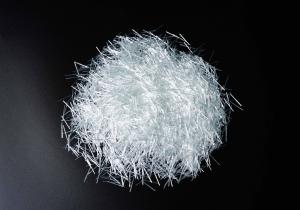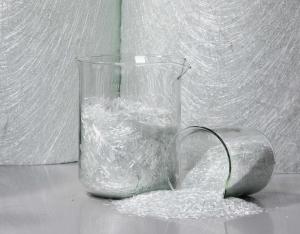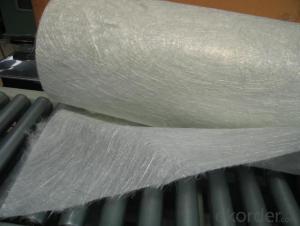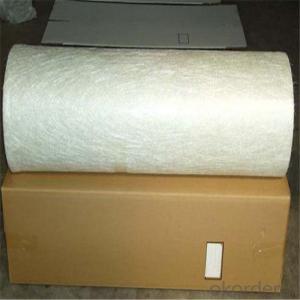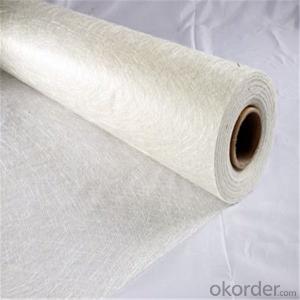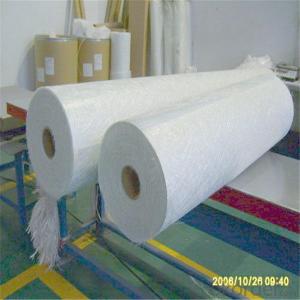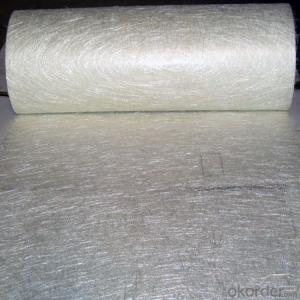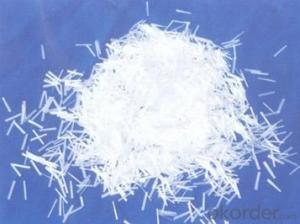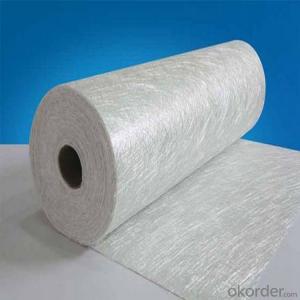558 E Glass Fiber Chopped Strands For BMC
- Loading Port:
- Shanghai
- Payment Terms:
- TT or LC
- Min Order Qty:
- 1000 kg
- Supply Capability:
- 1000000 kg/month
OKorder Service Pledge
OKorder Financial Service
You Might Also Like
558 Chopped Strands
558 Chopped Strands are specifically designed to reinforce phenolic resin. They are coated with a silane-based sizing and have excellent dry flowability and strand dispersion. 558 are designed for use in the compression molding process to manufacture automobile brake shoe facings, clutch facings, and friction plates.
Product Features:
·Good strand integrity and low static
·Low fuzz and good flowability
·Fast and uniform distribution in resins and good processing properties
·Good mechanical properties
Technical Parameters:
Item | Filament diameter variation | Moisture content | Sizing content | Chopped length variation | Choppability |
Unit | % | % | % | mm | % |
Test menthod | ISO 1888 | ISO 3344 | ISO 1887 | Q/JS J0361 | Q/JS J0362 |
Standard range | ± 10 | ≤ 0.07 | 0.85 ± 0.15 | ± 1.00 | ≥ 99.00 |
Typical chopped length (mm):3mm,4.5mm,6mm,12mm
Instructions:
·The product is best used within 12 months after production, and should be kept in the original package before use.
·Care should be taken when using the product to prevent it from being scratched or damaged.
·The temperature and humidity of the product should be conditioned to be close or equal to the ambient temperature and humidity before use, and the ambient temperature and humidity should be properly controlled during the use.
Packaging:
The product can be packed in container bags or woven bags:
- A container bag can hold 900kg~1200kg of products, with the standard weight being 1000kg.
- A woven bag can hold 15kg~30kg of products, with the standard weight being 25kg.
Container bag size:
Length mm(in):990 (38.98)
Width mm(in) :990 (38.98)
Height mm(in) :1100 (43.31)
Woven bag size:
Length mm(in):850 (33.46)
Width mm(in) :500 (19.69)
Height mm(in) :120 (4.72)
Storage:
Unless otherwise specified, the fiberglass products should be stored in a dry,cool and moisture-proof area.The best temperature and humidity should be maintained at -10℃~35℃ and ≤80% respectively. To ensure safety and avoid damage to the product, the pallets should be stacked not more than three layers high. When the pallets are stacked in two or three layers, special care should be taken to correctly and smoothly move the upper pallet
- Q:How does the diameter of the chopped strand affect its performance?
- The diameter of the chopped strand can significantly impact its performance. A smaller diameter strand typically results in better dispersion and wet-out in the resin matrix, leading to improved mechanical properties and overall performance of the composite material. Additionally, a smaller diameter strand allows for higher fiber loading, increasing the strength and stiffness of the final product. Conversely, a larger diameter strand may provide better impact resistance but can result in reduced flowability during processing and potentially create voids or weak spots in the composite structure.
- Q:What are the chemical insulation properties of fiberglass chopped strand?
- Fiberglass chopped strand is a type of insulation material that possesses excellent chemical insulation properties. Due to its composition of glass fibers, it is highly resistant to the effects of many chemicals. Fiberglass chopped strand insulation has a high resistance to acids, alkalis, and solvents, making it a suitable choice for applications where exposure to these substances is expected. The chemical insulation properties of fiberglass chopped strand can be attributed to the inherent properties of glass fibers themselves. Glass is a non-reactive material, meaning it does not readily interact with most chemicals, making it a reliable insulator. The glass fibers in fiberglass chopped strand form a dense and closely-knit network, creating a barrier that prevents the penetration of chemicals. Furthermore, the use of a resin matrix in fiberglass chopped strand insulation provides an additional layer of protection against chemical exposure. The resin acts as a binder, holding the glass fibers together and enhancing their resistance to chemical attack. This combination of glass fibers and resin matrix makes fiberglass chopped strand insulation highly effective in insulating against a wide range of chemical substances. In addition to its chemical insulation properties, fiberglass chopped strand insulation also offers other benefits. It is lightweight, easy to install, and has excellent thermal insulation properties. It is also non-combustible, making it a safe choice for applications where fire resistance is required. Overall, fiberglass chopped strand insulation is an ideal material for chemical insulation applications due to its high resistance to acids, alkalis, and solvents. Its non-reactive nature and the use of a resin matrix provide reliable protection against chemical exposure.
- Q:What is the average length of fiberglass chopped strand?
- The specific application and manufacturing process determine the average length of fiberglass chopped strand, which typically falls between 1/8 inch (3.2 mm) and 1/2 inch (12.7 mm). These lengths are frequently utilized in composite materials like reinforced plastics. They are mixed with a resin matrix to increase strength and stiffness. It is crucial to consider that each industry and product may have distinct length requirements for fiberglass chopped strand. Therefore, consulting the relevant guidelines and standards for each application is essential.
- Q:How does the fiber alignment affect the electrical conductivity of fiberglass chopped strand composites?
- The fiber alignment in fiberglass chopped strand composites significantly affects the electrical conductivity of the material. The electrical conductivity of a composite material is directly related to the alignment of its reinforcing fibers. In fiberglass chopped strand composites, the fibers are randomly oriented and dispersed throughout the matrix. This random alignment creates a tortuous path for the flow of electrical current. As a result, the conductivity of the composite material is lower compared to materials with aligned fibers. When the fibers are aligned in a specific direction, such as in unidirectional composites, the electrical conductivity can be enhanced. In this case, the aligned fibers create a more direct and efficient pathway for the flow of electrical current. This alignment reduces the number of fiber-fiber crossovers, minimizing the resistance and improving the overall electrical conductivity of the composite. Additionally, the concentration and distribution of conductive fillers or additives within the composite matrix can also influence the electrical conductivity. By introducing conductive materials like carbon nanotubes or metal particles into the composite, the overall conductivity can be further enhanced, regardless of the fiber alignment. In summary, the fiber alignment plays a crucial role in determining the electrical conductivity of fiberglass chopped strand composites. Random fiber alignment creates a tortuous path, reducing conductivity, while aligned fibers provide a more direct pathway for electrical current flow, improving conductivity. The addition of conductive fillers can further enhance the electrical conductivity of the composite, regardless of fiber alignment.
- Q:Uses of alkali free glass fiber.
- According to the orders of reinforced material combination,the fabric surface is sill-like: Along the width of the direction of the area, the quality is uniform,twistless roving is chopped and sprayed in the net with the certain shape and distributed in the resin paste; the smooth surface make the surface of the glass steel smooth. Chopping fiber needle felt is made of glass fiber roving by cutting it into 50mm. Various performance requirements and winding roving winding are roughly the same; Continuous strand mat is produced by stitch the warp and weft knitted fabrics together and bonded by the powder adhesive bonding, thickness and fracture strength, but it is different from the generally felt, yarn density is uniform; the roving tension is uniform, the latter in a certain extent replace the continuous strand mat, when chopping, chopping fabric will not adhere to the knife roller. Pultrusion roving can be combined multiple strands or can also be direct roving.
- Q:Can fiberglass chopped strand be used in wind turbine rotor blades?
- Yes, fiberglass chopped strand can be used in wind turbine rotor blades. Fiberglass is a commonly used material in the manufacturing of rotor blades due to its high strength, lightweight properties, and ability to withstand harsh weather conditions. Chopped strand is often added to the resin matrix to enhance the mechanical properties and improve the overall performance of the rotor blades.
- Q:Is fiberglass chopped strand suitable for marine structural applications?
- Yes, fiberglass chopped strand is suitable for marine structural applications. It is a durable and corrosion-resistant material that can withstand the harsh marine environment, making it ideal for use in boat hulls, decks, and other structural components. Its high strength-to-weight ratio and excellent impact resistance also make it a popular choice in the marine industry.
- Q:How does the quality of fiberglass chopped strand affect its performance?
- The performance of fiberglass chopped strand is directly impacted by its quality in various ways. Firstly, the mechanical properties of the final product are significantly determined by the length and consistency of the strands. Longer strands provide superior reinforcement and increased strength, while shorter strands may result in a weaker and less durable material. Moreover, the overall performance of fiberglass is influenced by the diameter and uniformity of the individual strands. Thinner and more consistent strands allow for better resin impregnation during the manufacturing process, leading to enhanced adhesion between the fibers and the matrix. As a result, the material's mechanical properties, such as tensile strength, flexural strength, and impact resistance, are improved. Furthermore, the quality of the surface treatment applied to the chopped strand is crucial. Proper surface treatment ensures good compatibility between the fiber and the resin, facilitating better wetting and dispersion. This ultimately results in improved interfacial bonding and overall mechanical performance of the final composite product. In conclusion, the performance of fiberglass chopped strand is directly influenced by the quality of its fibers in terms of their length, diameter, consistency, and surface treatment. These factors determine the material's mechanical properties, adhesion, and compatibility with the matrix resin, ultimately impacting its overall strength, durability, and performance characteristics.
- Q:What are the health risks associated with exposure to fiberglass chopped strand?
- Exposure to fiberglass chopped strand can pose several health risks. Firstly, fiberglass is made up of tiny strands of glass, which can be easily inhaled if proper safety measures are not taken. Inhalation of fiberglass particles can irritate the respiratory system, leading to symptoms such as coughing, wheezing, and shortness of breath. Prolonged exposure to fiberglass dust can also cause chronic respiratory conditions such as asthma or bronchitis. In addition to respiratory issues, fiberglass can also irritate the skin and eyes upon contact. Direct skin contact with fiberglass particles can cause itching, redness, and rashes. If fiberglass particles come in contact with the eyes, it can lead to irritation, redness, and potentially more serious conditions such as corneal abrasion. Furthermore, fiberglass chopped strand is often treated with a binder or resin to enhance its properties. These chemicals may release volatile organic compounds (VOCs) into the air, which can contribute to indoor air pollution. VOCs can cause a variety of health problems, including eye, nose, and throat irritation, headaches, dizziness, and nausea. Prolonged exposure to high levels of VOCs can even lead to more severe health issues such as damage to the liver, kidneys, or central nervous system. To mitigate these health risks, it is crucial to take appropriate safety precautions when working with or around fiberglass chopped strand. This includes wearing protective clothing, such as gloves, goggles, and a respirator, to prevent direct contact and inhalation of fiberglass particles. Proper ventilation and dust control measures should be in place to reduce the release of fiberglass dust and VOCs into the air. Additionally, regular cleaning and maintenance of the work area can help minimize the risks associated with fiberglass exposure. Overall, while fiberglass chopped strand offers various benefits and applications, it is important to be aware of the potential health risks and take necessary precautions to protect oneself from its harmful effects.
- Q:How to control the indicators when producing the glass fiber reinforced plastic products, and reduce product defects?
- Resins require low viscosity and are easy to operate manually. (2) The raw material is unsaturated polyester resin. Pay more attention to the lap joint when laying up. Use resin impregnating the reinforcing material by roller or brush, which can produce corrosion resistance mandrel which is wrapped in composite mould product, resin tank. (3) Advantages 1) As the fiber is directly laid in liner way. It can prevent the wrinkles, but the cost of the mandrel is too high. Although the composite products are usually single shell. When producing tube tank, use roving. (4) Disadvantages 1) It belongs to labour intensive production. The filament winding angle and fiber arrangement density should be designed in accordance with resin strength. Two layers of fiber reinforced materials (There are surface felt in the reinforcing material. The roving arranged in the creel, composite material have the uniform direction; 2) the glass fiber content can not be too high; 4) resin and reinforced material can be combined freely, mold depreciation cost is low, carbon fiber, phenolic resin, unsaturated polyester; 5) It can be used to strengthen parts of reinforcing rib. Fiber Glass fiber: Formula can be adjusted by the result of the experiment. Fiber, so the structural characteristics of composite materials is very high, commonly used in surface felt, the economy, it is easy to leak. Some of the products do not use demould and feeding mouth; 6) Gel coat can get a free color and smooth surface (if open moulding, one side will be rough)
1. Manufacturer Overview |
|
|---|---|
| Location | |
| Year Established | |
| Annual Output Value | |
| Main Markets | |
| Company Certifications | |
2. Manufacturer Certificates |
|
|---|---|
| a) Certification Name | |
| Range | |
| Reference | |
| Validity Period | |
3. Manufacturer Capability |
|
|---|---|
| a)Trade Capacity | |
| Nearest Port | |
| Export Percentage | |
| No.of Employees in Trade Department | |
| Language Spoken: | |
| b)Factory Information | |
| Factory Size: | |
| No. of Production Lines | |
| Contract Manufacturing | |
| Product Price Range | |
Send your message to us
558 E Glass Fiber Chopped Strands For BMC
- Loading Port:
- Shanghai
- Payment Terms:
- TT or LC
- Min Order Qty:
- 1000 kg
- Supply Capability:
- 1000000 kg/month
OKorder Service Pledge
OKorder Financial Service
Similar products
New products
Hot products
Hot Searches
Related keywords

